
(Photos by Jonathan Maus/BikePortland)
“I help you, you help me!”
Those aren’t the words you expect to hear during a competitive cycling event. But when the event — the third annual Disaster Relief Trials — is based around a mock disaster and the competitors are piloting 150 pounds or more of bike and cargo on a challenging, 35-mile course, teamwork takes priority over individual gain.
Around 40 riders took part in the DRT on Saturday. There were three classes of riders: The “replenish” class was billed as family friendly and participants were required to carry one other person (most opted for a young child). The “open” and “e-bike” classes were more competitive and had to tackle a longer, more challenging course.
The premise was that riders were responding to a major disaster, such as an earthquake, where trains, buses, and cars will have been rendered useless. Roads and bridges will have crumbled. Gasoline might be gone or in very short supply. Bicycles — especially ones with carrying capacity — will be the last vehicles standing.
Prior to the start, each competitor was given a map and manifest. Their mission was to leave from home base (an emergency response command center set up in the parking lot of the Oregon Museum of Science and Industry) and successfully navigate a variety of checkpoints. Open and e-bike class riders went as far south as Sellwood Riverfront Park, east to Sewellcrest Park (SE 32nd and Lincoln) and north to University of Portland and the Oregon Food Bank (NE 33rd and Columbia).
The checkpoints were more than a test of cycling skills. They tested each riders’ agility, sense of direction, creativity, patience, and will.
Advertisement
After filling five-gallon buckets with water (weighing about 45 pounds) from the Willamette River near the west end of the Hawthorne Bridge, the riders rolled south to Sellwood Park. Then it was north to Sewellcrest Park where things got interesting. For the remainder of the ride, the competitors would have to deal with a full-size pallet attached to their bikes. This awkward item was a test of packing skills. Some placed it flat on the front of their bikes, others tilted it vertically and strapped it to the side.
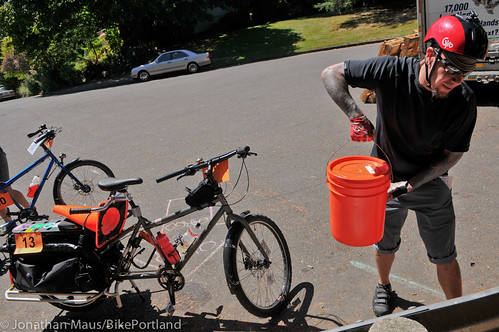
Once the pallet was strapped on, they had to lift it — and their bikes — over a three-foot railing. This created a bottleneck of riders at checkpoint 3 who barked instructions to each other in order to time their lifts. Once the bikes were over the obstacle, the riders hammered on their pedals to the next checkpoint — an industrial facility at N Cook and Mississippi.
This is where navigation proved invaluable. Several riders lost major time due to wrong turns and other navigation mistakes. Alexander Hongo and Lucas Strain came up from Eugene hoping to deliver an upset to the locals. But while riding north on Williams they missed the left turn on Fremont. By the time I saw them back at the finish line, Lucas said the mistake cost them several extra miles.
Here are some photos of the speedy riding between checkpoints 3 and 4…
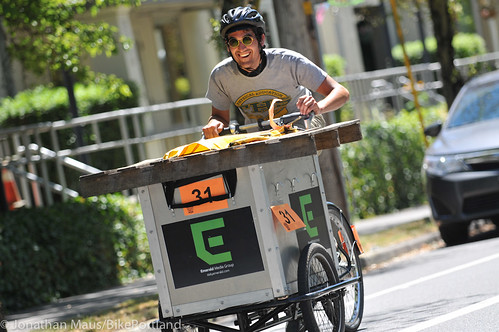
A few scenes from checkpoint 4…
By the time the riders reached the “Dirt” checkpoint on N Willamette Blvd, they had about 18 miles in their legs, a pallet, an eight-foot long 2 X 6 plank, and two full buckets of water on their bikes. And then it was time to tackle what many of them said was the hardest part of the entire course: a slippery singletrack trail and dirt hillclimb. The off-road section was hot and unforgiving on both riders and their bikes.
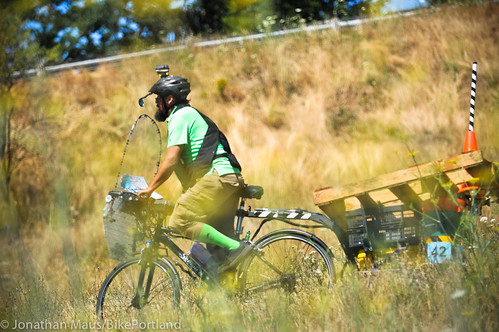
From there it was on to the last three checkpoints where the riders had to pull a victim in a sled behind their bikes, pick up a box of perishable food, and then take on four eggs — without breaking them — all the way back to the finish at OMSI.
While we waited at base camp for the riders to finish, the Cascadia Cargo Bike Fair was in full swing…

The first person to cross the line was Willy Hatfield with a time of three hours and eleven minutes. Hatfield is an engineer with Bike Friday and was riding a custom bike he designed specifically for the DRT (based loosely on the company’s “Haul-a-Day” model). Despite his unconventional bike and the fact that he admitted, “Nothing went to plan,” Hatfield got off to an early lead, chose good routes, and took home the victory.
In the e-bike class, Bend resident Sterling McCord finished first with a time of two hours and 25 minutes. The owner of Bend Electric Bikes, McCord rode a Bullitt “long John”-style cargo bike that he outfitted with an electric motor he assembled from secret parts.
Other finishers might not have been as fast, but this event isn’t about speed.
Tessa Walker rolled across several hours after the winners on her homemade, three-speed bike. “Amazing, ridiculous, awesome,” was how she described the experience to me. “The hardest part was when I realized it was just me, a pallet, and 40 pounds of water on some random street in Portland.”
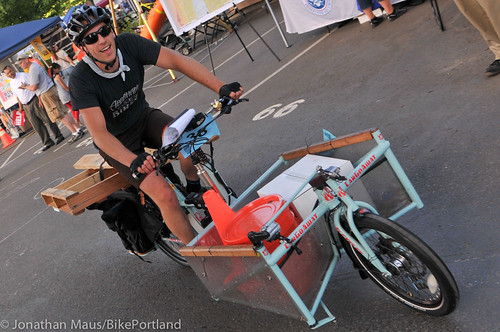
And then there was Cory Poole on a skateboard pulling a cargo trailer he built himself. It took him five hours and 11 minutes; but he got through every checkpoint and finished with the largest smile and the loudest ovation of the day.
Having proved the utilitarian prowess of cargo bikes, the organizers and riders attended a well-deserved afterparty at Islabikes in southeast Portland. The event featured an indoor bike track and entertainment from Dingo the Clown and Olive Rootbeer for the kids, and cold beverages for the adults.
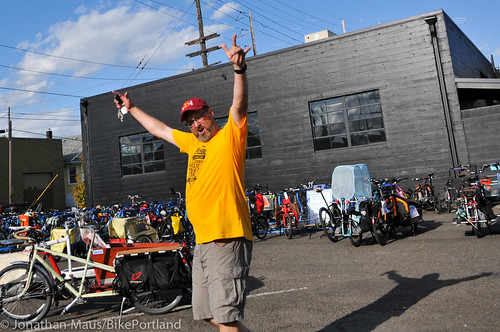
We’ve got lots more photos from the event over on Flickr. For more on the DRT, check out their website and follow them on Facebook.


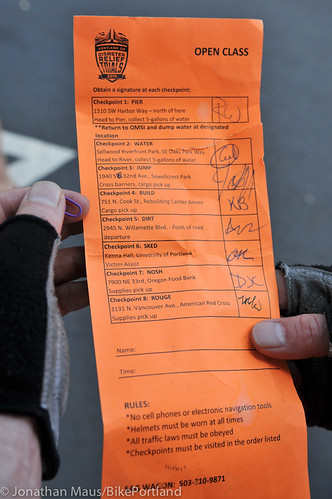
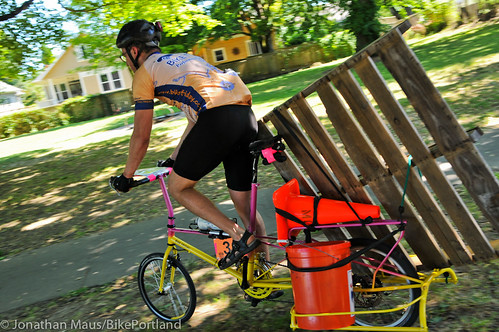
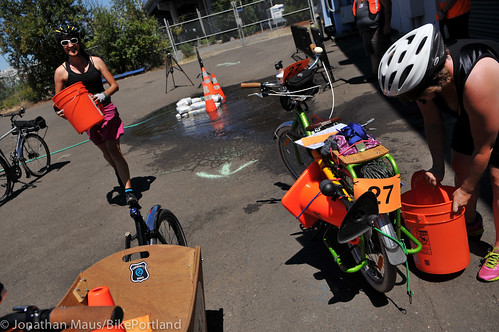
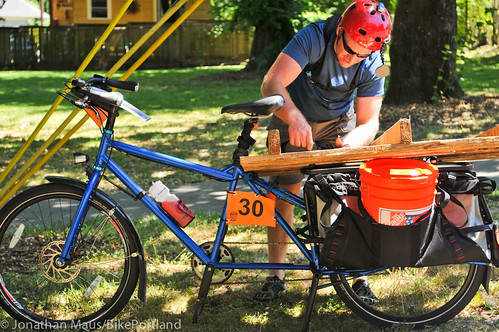
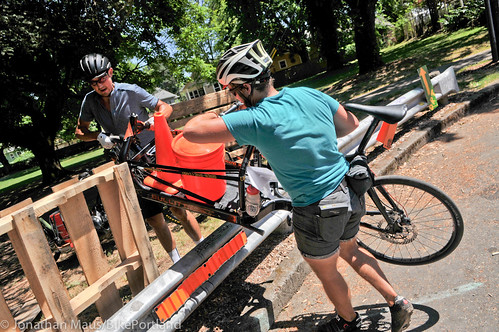
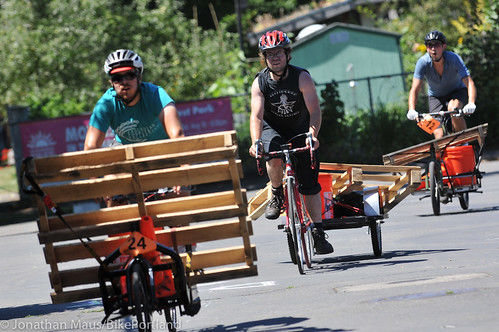


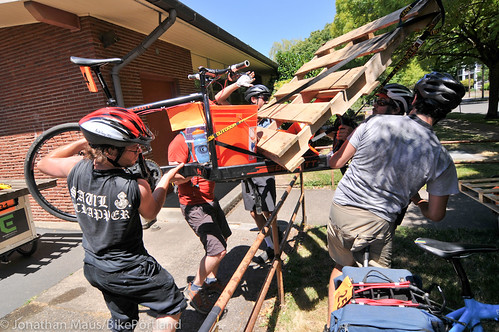
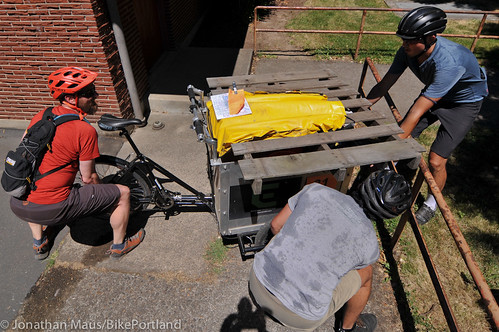

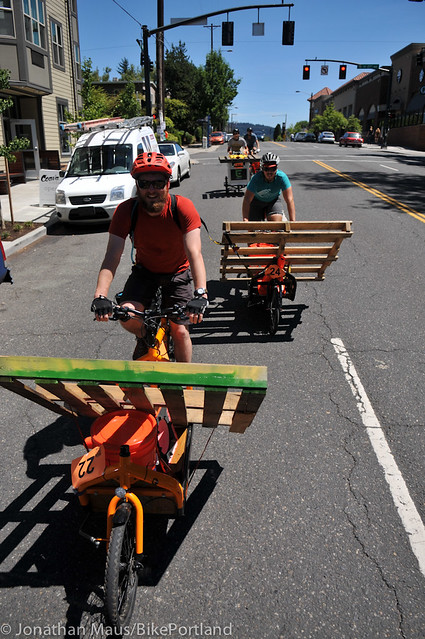
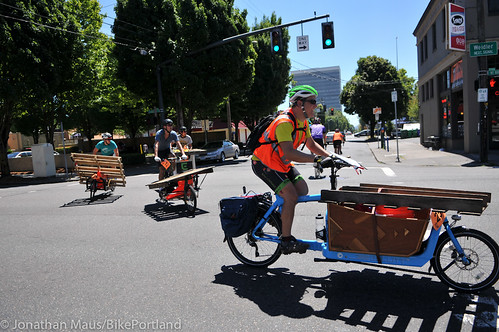
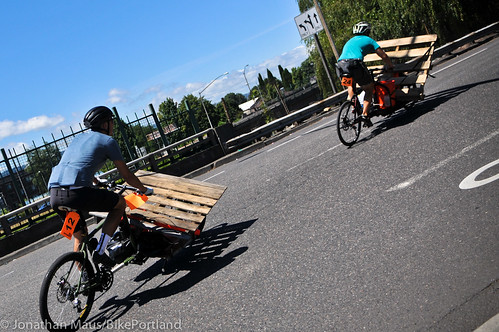
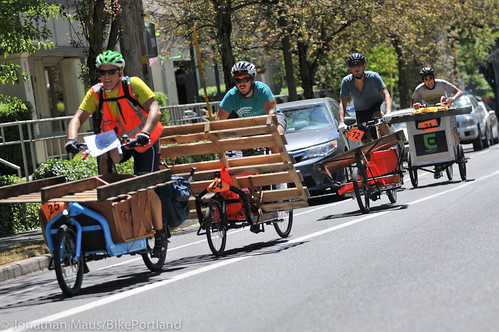
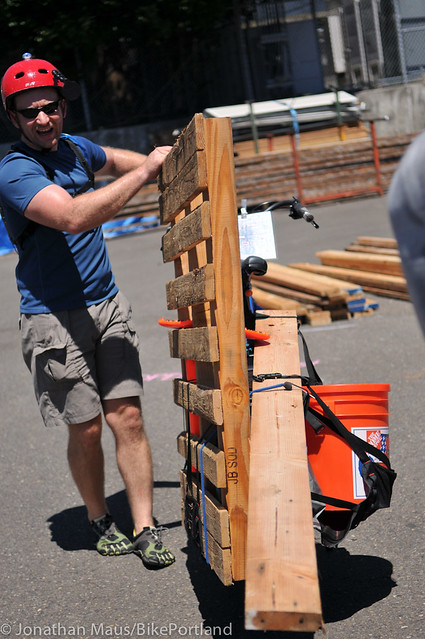
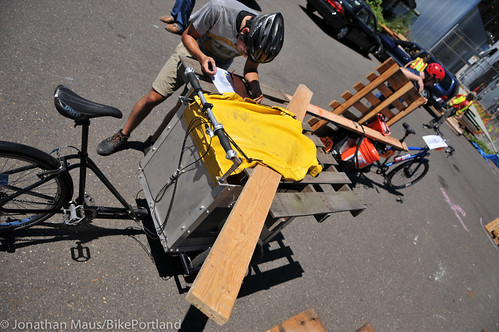
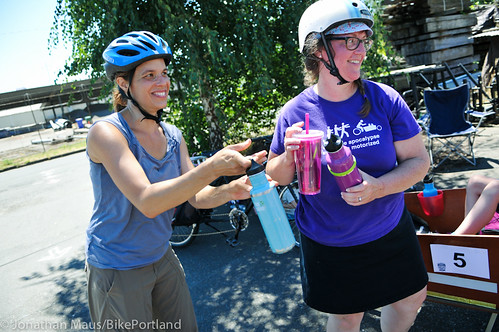
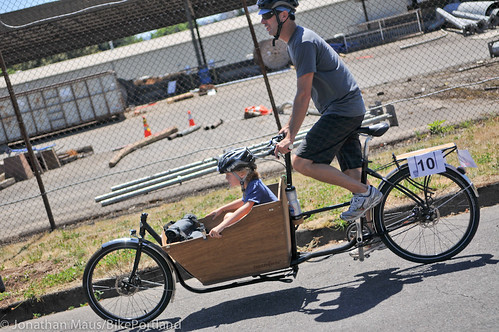
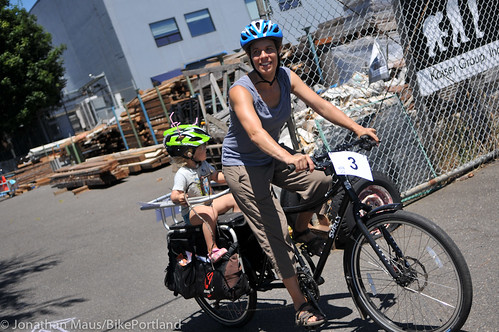
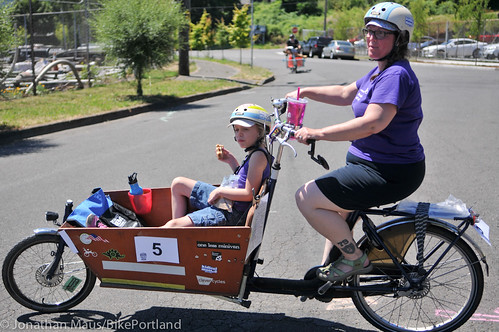
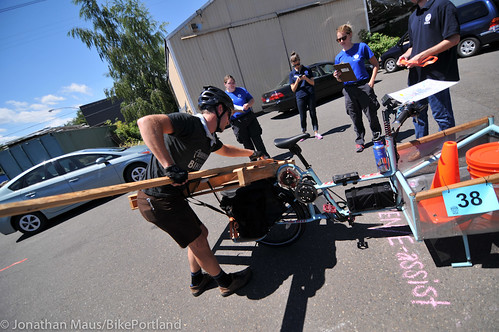
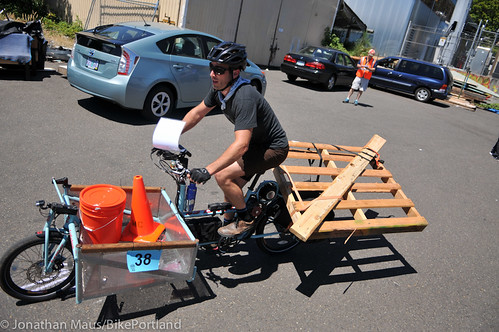
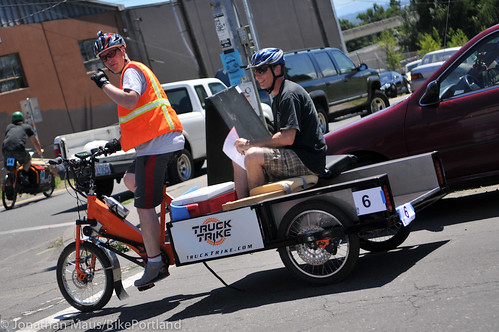

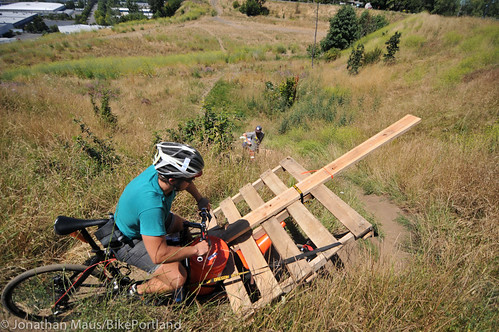
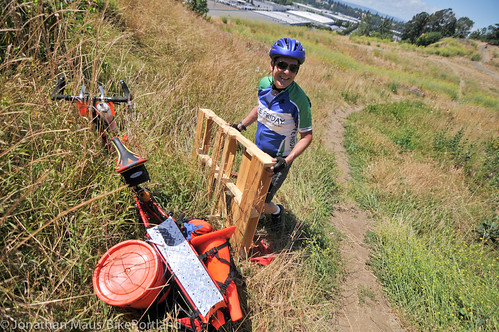
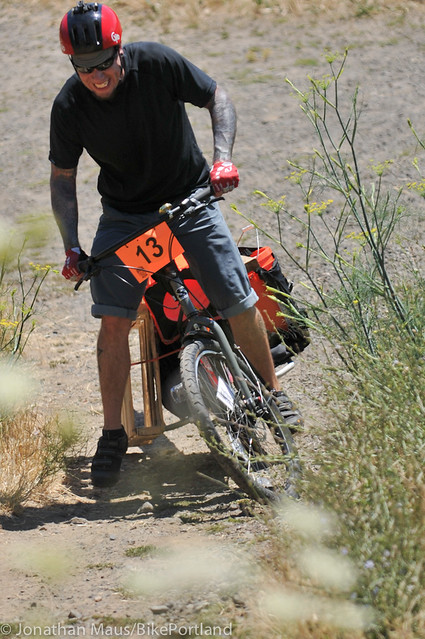
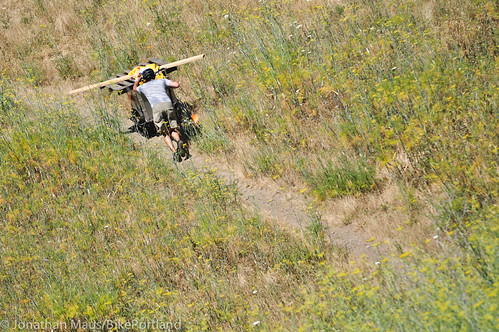
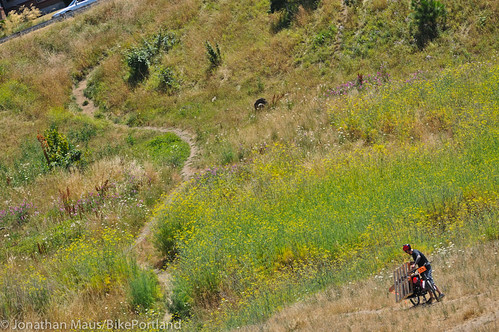
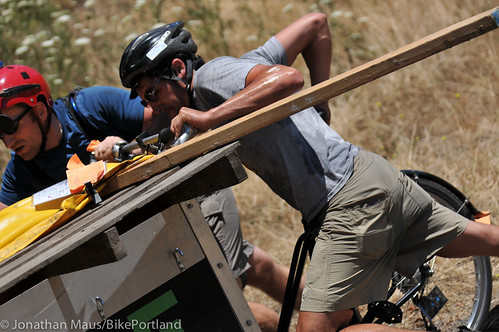
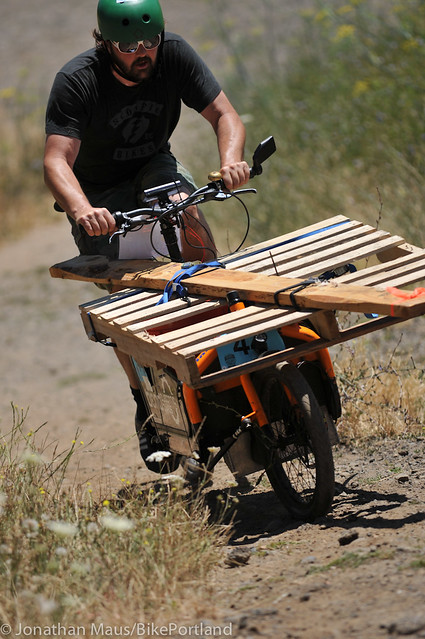
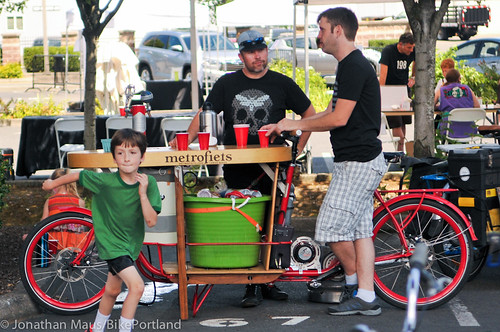

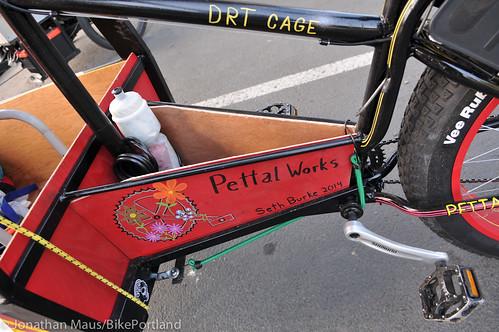
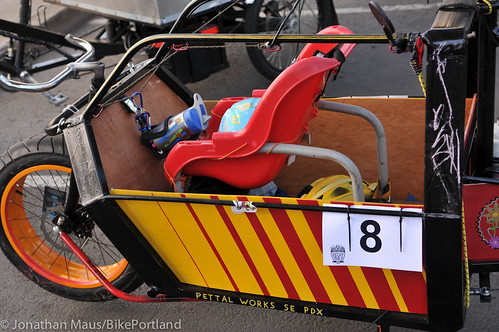
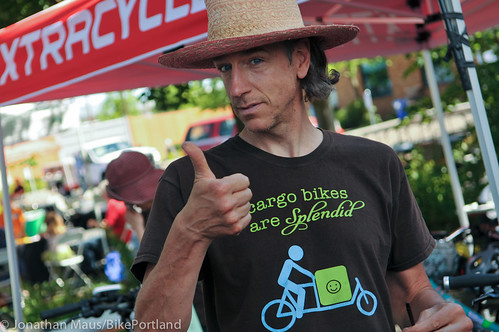
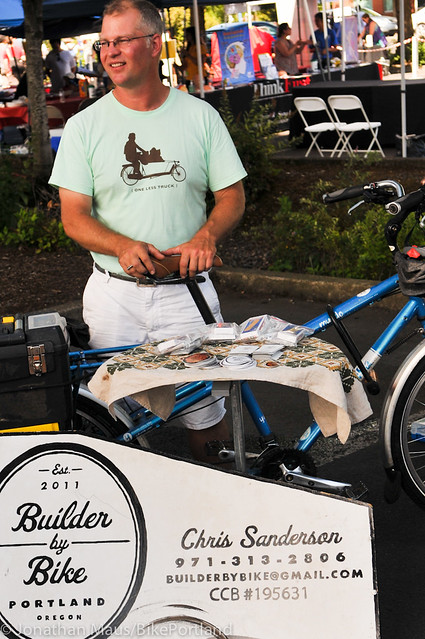
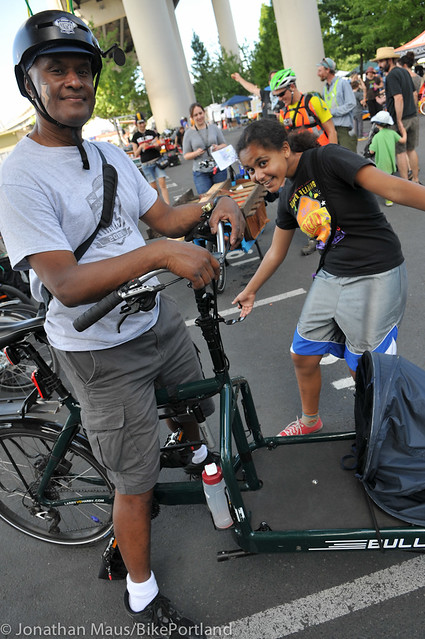
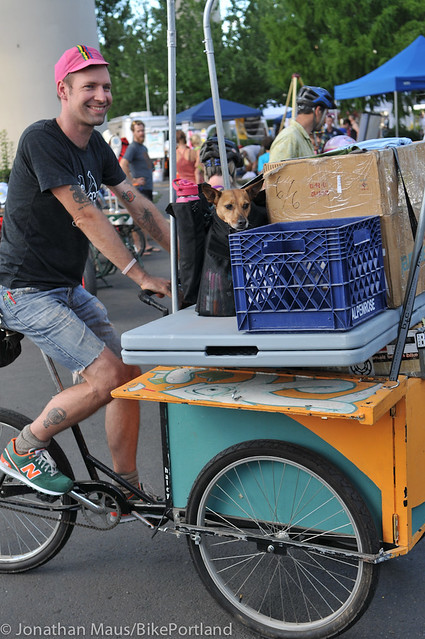
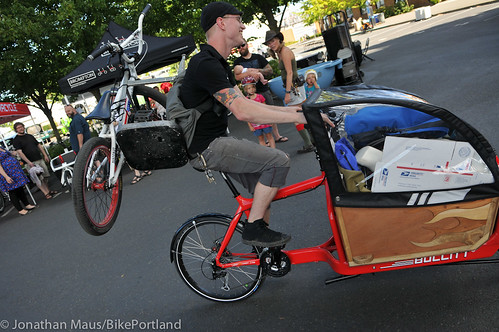
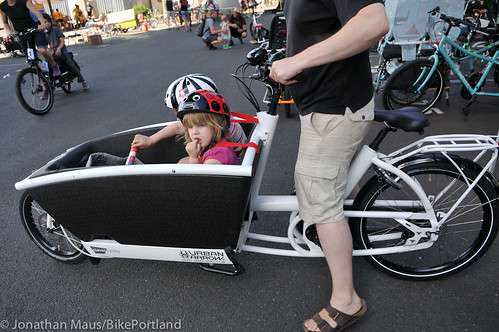
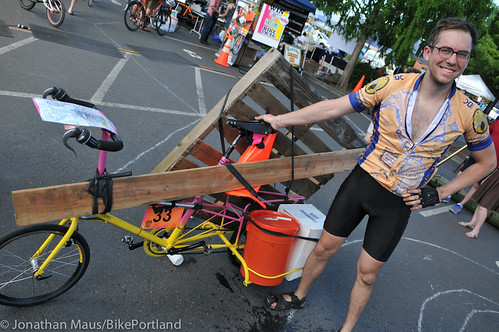
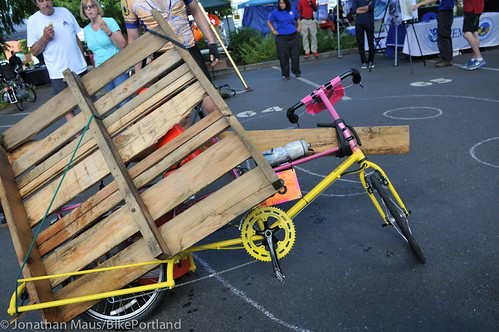
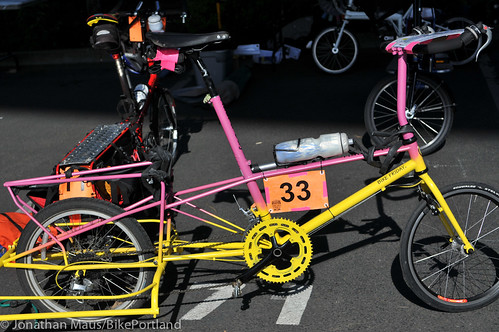
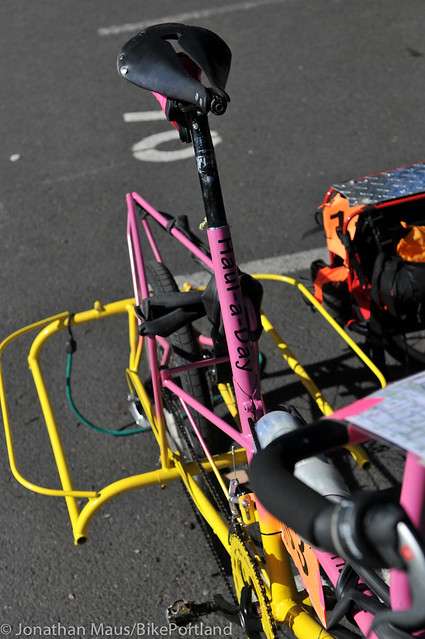

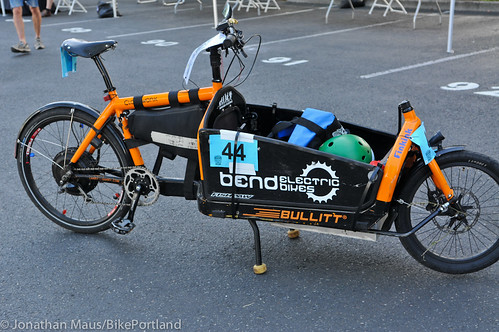

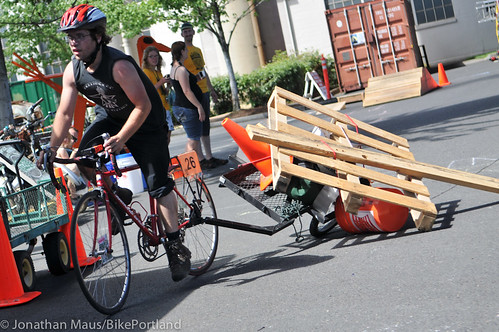
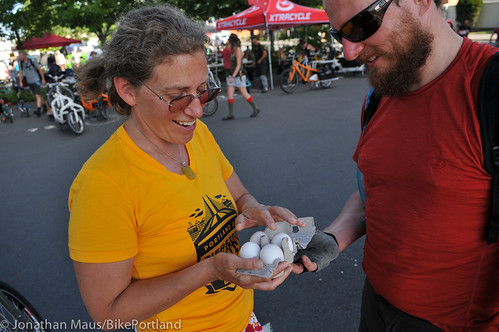
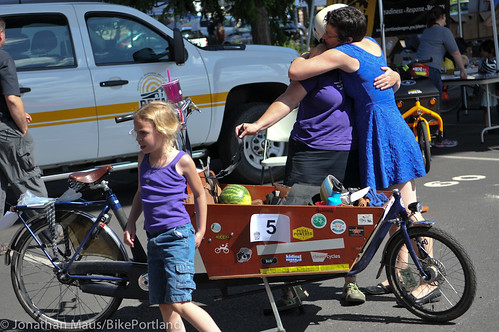
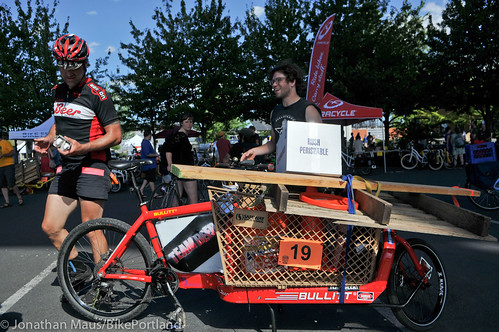
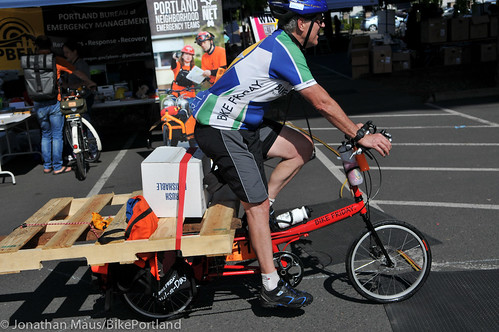
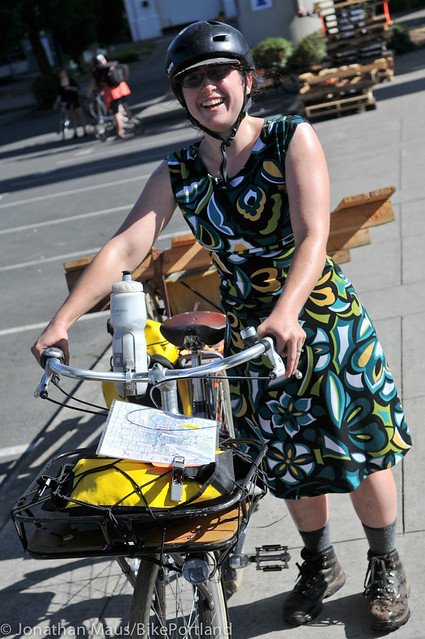
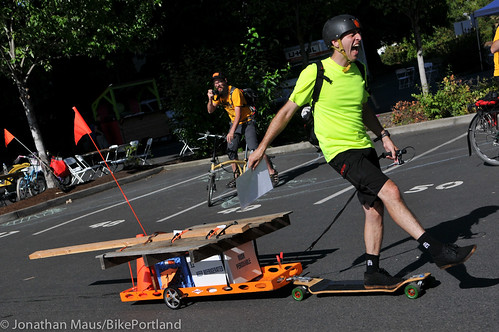
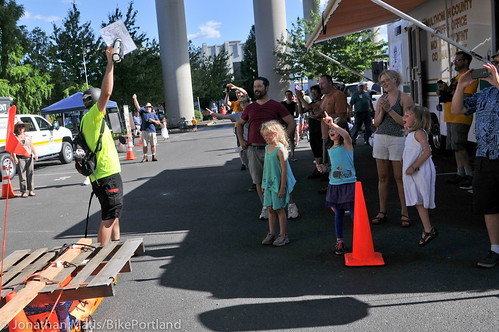

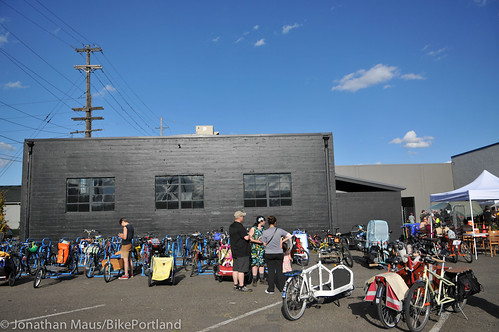
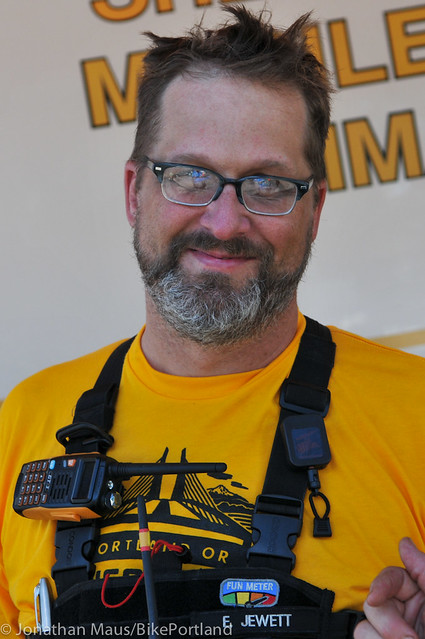
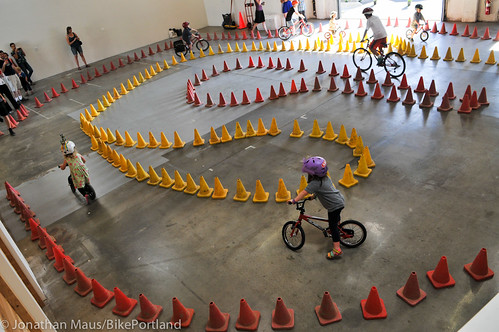
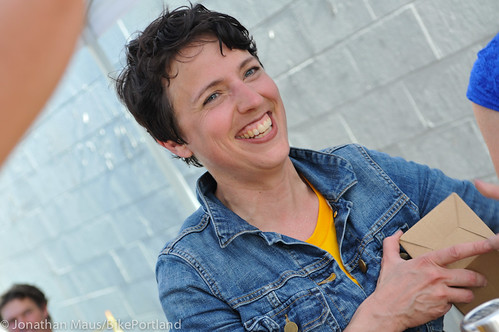
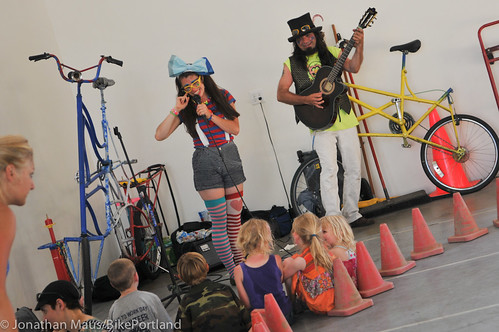
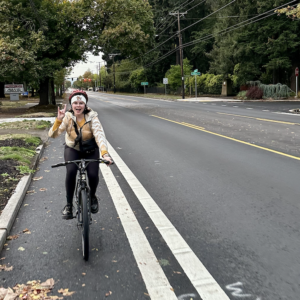

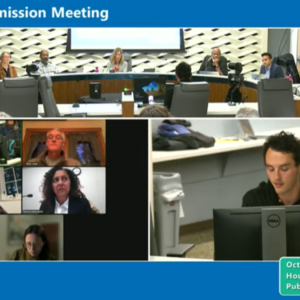
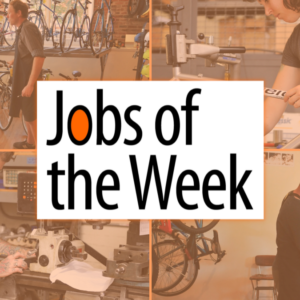
Thanks for reading.
BikePortland has served this community with independent community journalism since 2005. We rely on subscriptions from readers like you to survive. Your financial support is vital in keeping this valuable resource alive and well.
Please subscribe today to strengthen and expand our work.
So sorry to have missed this.
Very nice extensive writeup!
And not that I’m un-biased, but I have to say some of those loads look like they were made for a bike trailer. Glad to see there were a few present.
The uphill segment of that trail was the most challenging part of the race. Who would have thought that overinflated road tires are a bad idea on dirt tracks? Thanks Tyler for helping me get to the top!
I was just barely able to ride up the hill in the lowest gear on my Big Dummy, but it was on edge the whole time. That part was a lot of fun.
A tip for those trying this in the future: an extra minute strapping down your load will save you dozens of minutes later in the ride! I learned that one the hard way…
Nicely done Ryan! I still am grateful for you helping me get the Trailhead bike over that first barrier last year. Great event!
The idea of helping each other in a competition something so completely foreign in America that it we have trouble even conceiving that to win everyone else doesn’t have to lose.
Sharing victory, especially in the situation which this event simulates, is the best outcome. Perhaps the scoring system needs to be skewed to reward overall victory rather than smashing the other participants.
I can say as a Replenish Class rider (a family supply run vs Open Class’ community supply run) that teamwork is what made the day great. Thank you to the organizers for their hard work, and for marking Jodi and I as both finishing in 6th place instead of putting one of us as 6th and the other as 7th.
On getting lost: would it have been against the rules for participants to mark the route as they went?
Whenever I’m watching Walking Dead I keep thinking it couldn’t hurt to spray paint important messages and directional way finding markers on the roads or wherever. Zombies can’t read.
While spray paint is out of line for a game like this even duct tape arrows on the road could have helped fellow riders who are “navigationially challenged”.
Thanks for the amazing writeup Jonathan. I am impressed by how much of the far-flung elements you were able to capture in words and images. William, Emily, Anita, Travis, Kellie and myself are really enjoying such a broad overview. We work on this for months and yet none of us ever sees more than a little bit; most of us never leave the start/finish. Thanks for sharing so much of it. I’ll be spending some quality time with the longer Flickr photo set sometime this week.
I hope it’s not lost in the shuffle that Fiets of Parenthood was a really important part of making the event, especially the Cargo Bike Fair, such a vibrant part of the event. Andy, Dmitry and Sarah did a great job of making that possible.
PBEM and Mulnomah County really gave the event their collective all this year. Having so many NET volunteers at OMSI, and having FIRE on the diets course were both highlights for me.
What? No beer keg?
Looks like it was a blast and a half in addition to a great learning experience. Mrs Dibbly & I had other commitments and couldn’t make it to this one, but next year we’ll be there, even if it’s only for the Cargo Bike Fair.
It’s wonderful that there is some effort and thinking about disaster relief, but the best thing about this event is publicity.
The Cascadia Fault earthquake will come. That’s a certainty. And there’s a pretty solid chance it will happen in our lifetimes. There is also a solid chance that it will be the biggest earthquake in recorded history – with heavy shaking lasting for minutes. It has a good shot at being the largest scale natural disaster in the recorded human history of North America.
That means:
No bridges.
The rivers may be unnavigable because of debris.
Yes, bicycles will have a much easier time getting around and will be very useful tools.
But there will be desperate shortages of food and water.
(AKA bicycle fuel).
What’s Oregon doing about it?
I think this cargo bike event is the most substantial preparation to date.
(It trumps Sam Adams designation of official cell phone charging stations… probably).
“No bridges.”
good thing we nixed the CRC. Can you imagine how hard it would be to find the money (a second time) to rebuild a compromised $3, $4, $8, or $10B freeway interchange & bridge, right about when we’ll have plenty of other things needing rebuilding? Whatever happened to socking away some rainy day funds, ODOT? This is peacetime/pre-Big-One, and they’re already broke.
Max, While I agree that the scale of such an event would be unparalleled in terms of the disruption and damage, I don’t think we’d see quite the level of destruction you describe. We now have one bridge that would almost certainly survive. and we are at considerable remove from the kind of unbelievable shaking that will occur in coastal communities (with resultant tsunamis).
It will likely be very much like Christchurch, but with millions more people and vastly more geography impacted. Relief, even for a country as prosperous as ours, will be slow in coming. The area is just too vast for the kind of focused efforts we saw post-Katrina. Portland’s unreinforced masonry, and tilt-up commercial buildings will collapse and kill most occupants, but most of our 2×4 homes will not fall down on their habitants. If we can avoid major firestorms (no water in hydrants) we should get off fairly easy. People in Christchurch were still using pit toilets many months after their quake . . . we can expect the same here. Bikes will be that rare example of something that keeps on working.